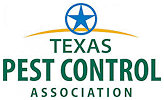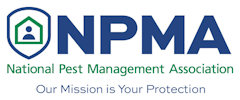The flying stinging-insects are probably the most feared when we are outdoors. Their painful sting makes us wary to them, but may also can extreme allergic reactions in people. Therefore the upmost care is taken when dealing with Bees, Wasps, and Hornets.
Wasps and Hornets are usually the most troublesome because they often nest on the outside of buildings in overhangs. Many wasps are extremely aggressive when provoked and can deliver a painful sting. Thankfully, not all wasps are aggressive. The Eastern Cicada Killer is a massive wasp that hunts cicada to kill and lay eggs in their prey. They pose little or no threat to humans, but can be damaging to lawns and gardens due to their large burrows. Not all wasps fly, however, and recently the Red Velvet Wasp, also known as the Cow Killer, has made its way to Texas. They are extremely aggressive and deliver the third most painful sting of any insect in the world, which may require hospital treatment.
If you have any questions, please ask about the Envirotrol Bee &Wasp Treatment Program.
Bees, however, are a different story from wasps and hornets. Bees are a requirement for the pollination of plants throughout the world and are in decline. Ask about our Bee Treatment Programs.
European Honey Bee
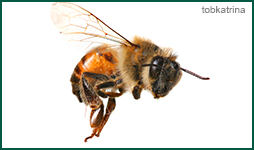
European Honey Bee - Apismellifera
ID: This is the most common type of bee in Texas. It is easily identified by its orange-yellow appearance with black stripes and being fluffy. They sometimes have bright orange bulbs on their back legs, this being pollen they have gathered from nearby flowering plants.
They create large hives with are attached to a structure, making them easy to remove and transport. Large honey bee conservations are underway to make sure they do not reach a critical minimum which would cause massive damage to the global agricultural environment.
Africanized Honey Bees look identical to European Honey Bees and are incredibly dangerous to any humans or pets around them as the bees attack indiscriminately. All honey bees are highly susceptible to delivering stings which can cause extreme allergic reactions in prone individuals. Which is why you should report any honey bee sighting regardless if they are friendly or not.
Bumblebee

Bumblebee - Bombus
ID: Bumblebees are easily recognized by their bright yellow colorations, fat body appearance, low-lying flight path, and their clumsy walking style which gives them the Bumble in their name. They drink and collect nectar from flowering plants and help pollinate the surrounding area.
Bumblebees are very uncommonly a pest as they nest in hives underground and rarely invade human structures. Their sting is relatively weak, but can deliver allergic reactions to susceptible people.
Paper Wasps
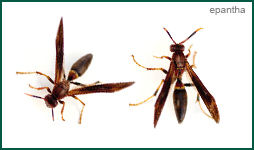
Paper wasps are the most common type of wasp in Texas. Their colorations range from a bright red to red, black, and yellow striping. They are mildly aggressive wasps and tend to strafe around the defender attempting to scare them off before delivering a sting.
Their nests are made of a papery material made by chewing up plant matter into a paste which hardens into paper. They make their nests under large overhangs and trees out of direct sunlight. They rarely make a nest within an enclosed space, which can make them potentially destructive.
They feed mostly on caterpillars and nectar fluids, but can also prey on beetle larvae and cicadas. They are also attracted to sweet foods and drinks by humans, due to them smelling like nectar.
They are attracted to humans due to loud noises, bright colors, perfumes, and sweet smells. Their sting is painful leaving localized swelling and itchiness. They can sting multiple times.
Yellow Jackets
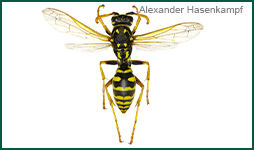
Yellowjacket - Vespulamaculifrons
ID: The yellowjacket is a type of wasp often misidentified as a bee due to their similar coloring and size. However, yellowjackets do not possess the fur, pollen sacs, and flattened hair hind legs that bees have.
The yellowjacket is bold and aggressive, and can sting repeatedly and painfully if provoked. It will mark aggressors, and will pursue them if agitated. They seldom cause allergic reactions.
The eastern yellowjacket builds its nests underground, also with the peak worker population between 1000 and 3000 individuals. Nests are built entirely of wood fiber and are completely enclosed except for a small entrance at the bottom. The color of the paper is highly dependent on the source of the wood fibers used. The nests contain multiple, horizontal tiers of combs within.
They can create massive nests, if left alone they can grow to the size of a small room. If you spot a yellowjacket in your home contact us immediately as they may cause extreme damage over time.
Cicada Killer
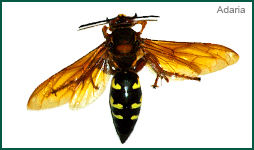
Cicada Killer - Spheciusspeciosus
ID: The Cicada is a very large solitary wasp that preys on cicadas as their primary source of food. They have large wings typically with a pale-orange color. Their legs are a bright orange and they have a black body with yellow spots or stripes. They can be 1/2”-2.5” or 1.3-6.4cm long.
This ground-burrowing wasp may be found in drained, sandy soils to loose clay in bare or grass-covered banks, berms and hills as well as next to raised sidewalks, driveways and patio slabs. Cicada killers may nest in planters, window boxes, flower beds or under shrubs, ground cover, etc. Nests often are made in the full sun where vegetation is sparse.
Although cicada killers are large, they are not aggressive and rarely sting unless they are grasped roughly, stepped upon with bare feet, or caught in clothing, etc.The stings are not much more than a "pinprick". Although they appear to attack anything that moves near their territories, cicada killers are actually investigating, such close inspection appears to many people to be an attack. They are generally non-aggressive towards humans and usually fly away when swatted at, instead of attacking.
Red Velvet Ant "Cow Killer"
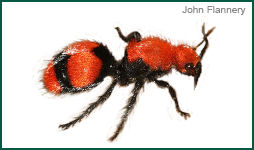
ID:The eastern velvet ant is the largest of the velvet ant species in the United States, attaining an approximate length of 3/4” or 1.9 cm. Adults have a black overall coloring with an orange-red pattern on the dorsal surface of the thorax and abdomen. They are covered in dense, velvet-like hair.
Commonly mistaken for an ant, because of its appearance and its common name, it is actually a unique species of wasp in which the females are wingless. It can be recognized by its black and orange-red striped coloring. When looking for food and a place to nest, females crawl rapidly along the ground. They also make a squeaking noise to communicate concern.
The velvet ant has multiple defensive strategies, but is best known for its painful sting, earning it the nickname of "cow killer". The sting is rated on the Schmidt Pain Index as one of the top five most painful stings in the world. Never attempt to handle one. Its defenses include the ability to run fast and evasively, warning coloration, stridulatory sounds, a chemical secretion, and venom.
